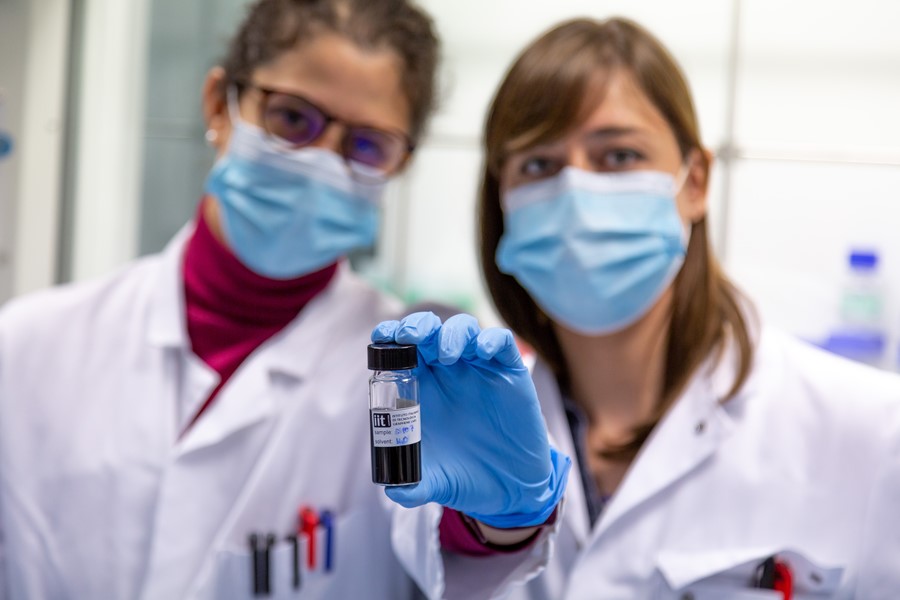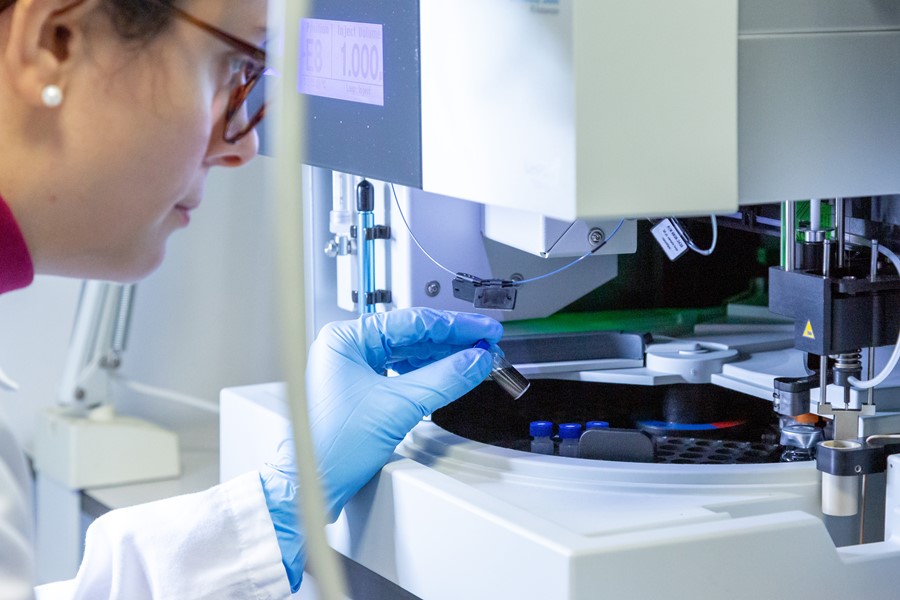Spotlight: Graphene applications in drug delivery
Graphene Flagship researchers Valentina Castagnola and Clarissa Braccia, based at Graphene Flagship partner IIT, in Italy, share their latest experiences and discoveries in the field of graphene and related materials.
What are the main breakthroughs of your latest work?
The layer of biomolecules naturally adsorbed on the surface of certain materials, like graphene, can drive their journey into the body. Our work investigated the role of lipids in mediating graphene interactions with cells. This is important to better understand how we could exploit graphene in nanomedicine, for applications like drug delivery. Discovering the biological interactions of layered materials is also essential to design them for specific purposes, such as precise targeting.
Why was graphene key to these advances?
Graphene and related materials have attracted a growing interest for their potential applications in biomedicine because of their excellent biocompatibility, surface functionalization and cargo capability. Therefore, graphene-based materials represent a promising “carrier” for drug delivery applications. In our work, we use two types of graphene with different surface chemistry: pristine graphene and graphene oxide. We identified a precise relation between the surface, the lipids adsorbed on it and the final internalization by brain endothelial cells, which is the main component of the blood-brain barrier. These correlations are crucial to design our graphene-based materials for specific biomedical applications.
Unfortunately, "corona" has acquired a very specific meaning lately - could you explain what exactly is the biomolecular corona?
The term “biomolecular corona” was coined in 2007 by Prof. Kenneth Dawson’s group at University College Dublin, in Ireland, inspired by the sun’s corona. When a nanomaterial gets in contact with a biological environment, like blood or other biological fluids, the biomolecules naturally present in the biofluids, such as protein, metabolites, or lipids… it spontaneously adsorbs onto the surface, creating a biolayer. This “corona” layer defines the final surface of the nanomaterial, also called biological identity.
What is the biological relevance of the biomolecular corona ?
The “wrapping” is a natural and unavoidable process occurring when a nanomaterial comes in contact with biofluids in the body. Therefore, we need to understand it in order to exploit it. Knowing the layer of biomolecules that will cover the surface of our material once injected in the body will allow us to predict their final fate (biodistribution, excretion, targeting efficacy, cellular uptake, etc.). As we demonstrated in our work, the composition of this layer is also strictly connected to the surface features of the material.
What was the importance of collaboration, particularly within the Graphene Flagship framework, in these studies?
Collaborations within the Graphene Flagship are essential for this kind of studies. All the materials used were provided and characterised by Ester Vazquez at Graphene Flagship partner UCLM, in Spain, members of our Work Package on Health and Environment. They also investigated the stability of these materials in the conditions we used for our experiments. Most importantly, during the Graphene Flagship meetings, we have the opportunity to show our results and discuss them with a network of experts in the field, allowing us to expand our knowledge and critical thinking.
Why did you decide to study the properties of graphene and related materials?
CB: Because I think they are the materials of the future. And I like being involved in projects directly correlated to such innovative materials. I am happy to work on something that can make a difference in so many fields of study.
VC: I have been investigating the biological interactions of graphene-based materials since 2015. These are exceptional and promising, but also tough to handle in the biological context. This represents a challenge that makes the work very stimulating and, I believe, once overcome, will open up to a technological revolution.
What do you think of international collaboration projects like the Graphene Flagship?
CB: I think that having a role in such an international environment is a wonderful opportunity for young scientists because you work side-by-side with colleagues from different fields and backgrounds. This allows your horizons to widen.
VC: Large international collaborative projects are a vital opportunity for young scientists to learn and develop a network that can be exploited for building new consortia and projects. In my case, the people I have met and the challenges I have faced in the context of EU collaborative projects were essential for my personal and professional development.
We have also participated virtually in the Graphene Week 2021 and presented this work on corona lipids in the Virtual Booth assigned to IIT. In all the events, the most motivating aspect for us is the opportunity to exchange with young scientists and experts in the field, sharing knowledge and creating long-lasting connections with people.
As an early career researcher, where do you see your field going?
CB: I have the feeling that the future for my field would be the study and the development of new tools to exploit the so-called “personalized pharmacological approaches”.
VC: Given the developments of nanomedicine in the last years, I believe we should move towards hybrid biomimetic approaches that allow exploiting the nanomaterials' functional features and the endogenous biological crosstalk.
What are your plans for the future?
CB: I’m at the very beginning of my scientific career (it’s my first year as a post-doc), and I have so many opportunities in front of me that it’s hard to tell what I am going to do. I hope that I’ll continue my work in research and maybe one day I could also have my own projects to lead.
VC: I consider it a privilege to work as a researcher. Here in IIT, I have the opportunity to do research at a high level, direct students and projects, and learn from excellent PIs experience. In the future, I aim to pursue my research and bring my contribution to the field, leading a team of young and motivated people. I am working hard in this direction.
References
Isobaric Labeling Proteomics Allows a High-Throughput Investigation of Protein Corona Orientation. Nara Liessi, Luca Maragliano, Valentina Castagnola, Mattia Bramini, Fabio Benfenati, and Andrea Armirotti. Analytical Chemistry 2021 93 (2), 784-791 (DOI: 10.1021/acs.analchem.0c03134).
The lipid composition of few layers graphene and graphene oxide biomolecular corona. Clarissa Braccia, Valentina Castagnola, Ester Vázquez, Viviana Jehová González, Fabrizio Loiacono, Fabio Benfenati, Andrea Armirotti. Carbon 2021 185, 591-598 (DOI: 10.1016/j.carbon.2021.09.052).

Graphene Flagship researchers Valentina Castagnola (right) and Clarissa Braccia (left), based at Graphene Flagship partner IIT, in Italy, share their latest experiences and discoveries in the field of graphene and related materials.

Graphene Flagship and IIT researcher Clarissa Braccia at the lab.




